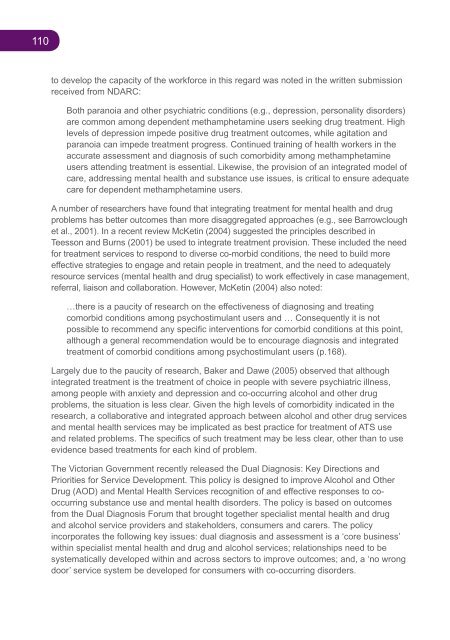National Amphetamine-Type Stimulant Strategy Background Paper
National Amphetamine-Type Stimulant Strategy Background Paper
National Amphetamine-Type Stimulant Strategy Background Paper
Create successful ePaper yourself
Turn your PDF publications into a flip-book with our unique Google optimized e-Paper software.
110<br />
to develop the capacity of the workforce in this regard was noted in the written submission<br />
received from NDARC:<br />
Both paranoia and other psychiatric conditions (e.g., depression, personality disorders)<br />
are common among dependent methamphetamine users seeking drug treatment. High<br />
levels of depression impede positive drug treatment outcomes, while agitation and<br />
paranoia can impede treatment progress. Continued training of health workers in the<br />
accurate assessment and diagnosis of such comorbidity among methamphetamine<br />
users attending treatment is essential. Likewise, the provision of an integrated model of<br />
care, addressing mental health and substance use issues, is critical to ensure adequate<br />
care for dependent methamphetamine users.<br />
A number of researchers have found that integrating treatment for mental health and drug<br />
problems has better outcomes than more disaggregated approaches (e.g., see Barrowclough<br />
et al., 2001). In a recent review McKetin (2004) suggested the principles described in<br />
Teesson and Burns (2001) be used to integrate treatment provision. These included the need<br />
for treatment services to respond to diverse co-morbid conditions, the need to build more<br />
effective strategies to engage and retain people in treatment, and the need to adequately<br />
resource services (mental health and drug specialist) to work effectively in case management,<br />
referral, liaison and collaboration. However, McKetin (2004) also noted:<br />
…there is a paucity of research on the effectiveness of diagnosing and treating<br />
comorbid conditions among psychostimulant users and … Consequently it is not<br />
possible to recommend any specific interventions for comorbid conditions at this point,<br />
although a general recommendation would be to encourage diagnosis and integrated<br />
treatment of comorbid conditions among psychostimulant users (p.168).<br />
Largely due to the paucity of research, Baker and Dawe (2005) observed that although<br />
integrated treatment is the treatment of choice in people with severe psychiatric illness,<br />
among people with anxiety and depression and co-occurring alcohol and other drug<br />
problems, the situation is less clear. Given the high levels of comorbidity indicated in the<br />
research, a collaborative and integrated approach between alcohol and other drug services<br />
and mental health services may be implicated as best practice for treatment of ATS use<br />
and related problems. The specifics of such treatment may be less clear, other than to use<br />
evidence based treatments for each kind of problem.<br />
The Victorian Government recently released the Dual Diagnosis: Key Directions and<br />
Priorities for Service Development. This policy is designed to improve Alcohol and Other<br />
Drug (AOD) and Mental Health Services recognition of and effective responses to cooccurring<br />
substance use and mental health disorders. The policy is based on outcomes<br />
from the Dual Diagnosis Forum that brought together specialist mental health and drug<br />
and alcohol service providers and stakeholders, consumers and carers. The policy<br />
incorporates the following key issues: dual diagnosis and assessment is a ‘core business’<br />
within specialist mental health and drug and alcohol services; relationships need to be<br />
systematically developed within and across sectors to improve outcomes; and, a ‘no wrong<br />
door’ service system be developed for consumers with co-occurring disorders.

















